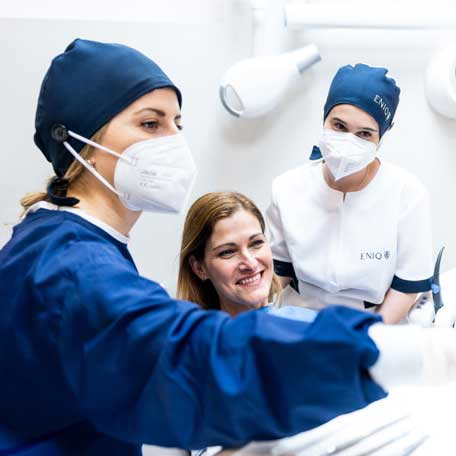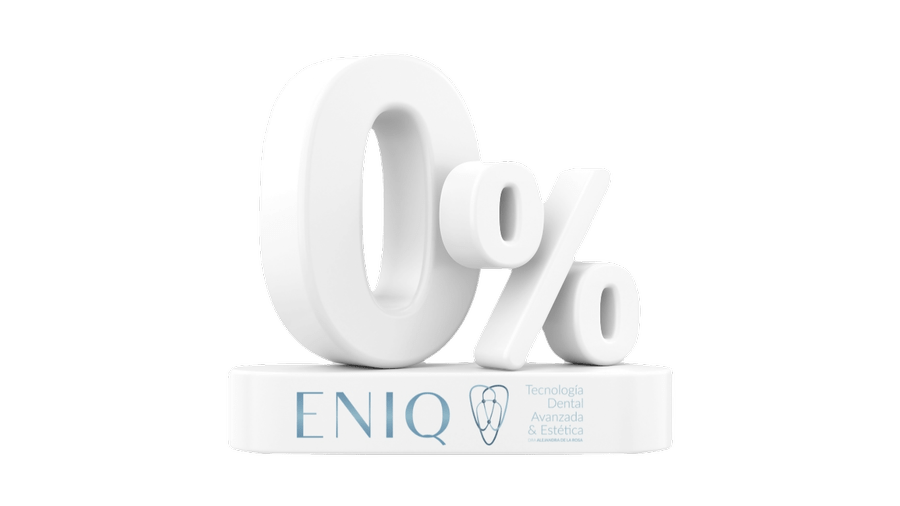

Child Dental Appliances
Friendly and effective treatments for children's dental health.
What is Interceptive Orthodontics?
Interceptive orthodontics is a branch of dentistry that focuses on the early diagnosis and treatment of dental and facial problems in growing children. Its main goal is to correct malocclusions and bone abnormalities during the development stage, before they become more serious problems requiring more invasive interventions, such as orthognathic surgery.
Interceptive orthodontics is used to correct issues such as dental crowding, open bites, crossbites, overbites, and underbites, among others. The devices used in this type of treatment can be removable or fixed, depending on the specific situation of the patient.
The advantage of interceptive orthodontics lies in its ability to favorably guide facial and dental growth, taking advantage of the active growth phase in children. This allows for less invasive and more efficient correction of problems compared to treatment in later stages of life.
It is important to note that interceptive orthodontics is only one part of complete orthodontic treatment. After the early intervention phase, additional treatment with traditional orthodontic appliances may be required to achieve optimal results and stabilize the position of the teeth and facial structures.
What are the phases of interceptive orthodontics?
- Preventive Orthodontics: This is orthodontics practiced on children. It prevents potential anomalies in tooth growth. Removable appliances are used, and it is based on teaching the child to have good habits and eradicate behaviors that can affect dental growth, such as thumb sucking.
- Corrective Orthodontics: This is the orthodontic treatment applied when the baby teeth have already changed. Through small gradual movements, dental arches are aligned.
In summary, interceptive orthodontics is a modality of treatment in dentistry that focuses on correcting dental and facial problems in children during their growth, with the goal of preventing more serious issues in later stages of life.
Duration
How long should a child wear removable appliances for interceptive orthodontics?
This depends on the nature of the dental or facial problem being treated and the individual patient's response to the treatment. Generally, the period of use can vary from a few months to several years.
The orthodontist will determine the duration of treatment based on several factors, such as the severity of the malocclusion, the age of the patient, and the progress observed during follow-up visits. In some cases, the goal may be to guide the growth and development of bones and teeth to correct problems at an early stage, and once the desired result is achieved, the use of removable appliances can be discontinued.
It's important to note that the use of removable appliances requires patient cooperation, especially in the case of children. It's crucial that they follow the orthodontist's instructions on daily wear time and proper care of the devices. If the child does not comply with the recommended use or does not follow the professional's instructions, it can affect the efficacy of the treatment and prolong its duration.

It's crucial to schedule regular follow-up visits with the orthodontist to assess progress and make necessary adjustments in the treatment. During these visits, the orthodontist can determine whether it's appropriate to continue with the removable appliances or if a different treatment modality is required, such as the placement of fixed braces.
In summary, the duration of using interceptive removable appliances varies depending on the case and individual needs of the patient. The orthodontist will be the one to evaluate progress and determine how long it's necessary to wear the removable appliances to achieve the desired results.

Which option is more beneficial: using a removable appliance or waiting to place braces?
The choice between using a removable appliance or waiting to place braces depends on several factors, such as the nature and severity of the dental problem, the age of the patient, availability of treatment, and individual preferences.
Removable appliances are commonly used in interceptive orthodontics, as they can correct certain dental and facial problems in early stages of development. These devices are adjustable and can be removed by the patient, which facilitates oral hygiene and allows for adjustments as needed. Removable appliances can be effective for correcting certain types of malocclusions and offer flexibility in treatment.
On the other hand, braces, which are fixed appliances attached to the teeth, are commonly used in conventional orthodontic treatment. These braces allow for greater control and precision in correcting more complex issues and provide more permanent results. However, their placement involves more intervention and requires regular visits to the orthodontist for adjustments and maintenance.
The decision on which option is better will depend on the analysis and diagnosis by an orthodontist. In some cases, it may be advisable to start with a removable appliance to address mild or moderate issues and then move on to treatment with braces if necessary. In other cases, where the malocclusion is more severe, it may be more appropriate to start directly with braces.
It is important to consult with a qualified orthodontist to assess the individual case and determine the best treatment option. The professional will consider various factors such as the patient's age, the severity of the malocclusion, bone structure, and specific needs, before recommending the most appropriate approach.
At what age are interceptive appliances typically placed in children?
Interceptive appliances in children are typically placed at an early stage of dental and facial development, generally between 6 and 10 years of age. This phase is considered the ideal window of opportunity to address certain issues and correct malocclusions more effectively.
The placement of interceptive appliances is based on leveraging the active growth and development of bones and teeth during this stage. At this phase, the facial bones are still growing and are more malleable, which facilitates the correction of skeletal and dental problems before they become more difficult to treat in later stages of life.
It's important to note that each child is unique, and the exact age to start interceptive treatment can vary based on individual needs and development. The orthodontist will assess the case comprehensively, considering factors such as the type and severity of the malocclusion, the child's facial growth, the eruption of permanent teeth, and other relevant factors.
For this reason, it's advisable for parents to take their children for an early orthodontic evaluation, around the age of 6, so the orthodontist can detect any issues in their early stages and determine if interceptive treatment is required.
Remember, early detection and timely treatment can help correct dental and facial problems more efficiently, avoiding future complications and reducing the need for more invasive interventions in later stages of life.
Is it feasible to replace removable orthodontics with Invisalign in children?
Yes, Invisalign is a system of clear, removable aligners that can be used as an alternative to traditional removable orthodontic appliances in certain cases. Invisalign uses a series of custom-made, clear aligners that are placed over the teeth and apply gentle pressure to gradually move them to the desired position.
Invisalign offers several advantages compared to traditional removable appliances. Some of these advantages include:
- Aesthetics: The clear aligners of Invisalign are virtually invisible, making them aesthetically appealing and discreet during treatment.
- Comfort: The aligners are smooth and designed to fit comfortably on the teeth, reducing irritation and discomfort associated with traditional appliances.
- Removability: The aligners of Invisalign can be easily removed for eating, brushing, and special activities, providing more flexibility and ease of oral hygiene.
However, it's important to note that not all cases are suitable for treatment with Invisalign. The effectiveness of Invisalign depends on the complexity and severity of the malocclusion, as well as the patient's cooperation in consistently wearing the aligners and following the orthodontist's instructions.
Therefore, an individualized evaluation with a certified Invisalign orthodontist is necessary to determine if this system is suitable for the patient and can replace conventional removable orthodontic appliances. The orthodontist will assess the case and recommend the most appropriate approach to achieve the desired results safely and effectively.
What are the benefits of performing child dental appliance treatments at ENIQ?
The use of technology in orthodontic treatments, such as Invisalign or other advanced systems, offers several benefits for patients. Here are some of the main benefits:
- Aesthetics: Technological treatments offer more aesthetic options compared to traditional appliances. For example, Invisalign uses clear aligners that are nearly invisible, allowing patients to improve their smile discreetly.
- Comfort: Technologically advanced appliances are usually more comfortable to wear than traditional appliances. The clear aligners from Invisalign, for example, are made of a soft material and do not have wires or brackets that can cause irritation in the mouth.
- Improved Oral Hygiene: Removable appliances, like Invisalign aligners, allow for better oral hygiene compared to fixed appliances. The aligners can be removed for brushing teeth and flossing, making it easier to clean teeth and gums properly.
- Fewer Orthodontist Visits: Some technological treatments can reduce the number of necessary visits to the orthodontist compared to conventional treatments. This is because several sets of Invisalign aligners can be provided at once, allowing the patient to change them at home as directed by the orthodontist.
- Increased Precision: The technology used in orthodontic treatments, such as 3D digital scanning and computer planning, allows for greater precision in planning and executing treatment. This can lead to more predictable and efficient outcomes.
- Digital Monitoring: Some technologically advanced orthodontic systems allow for digital monitoring of treatment progress. Patients can receive follow-up and feedback from their orthodontist through online platforms, streamlining the process and providing greater convenience.
It's important to note that specific benefits may vary depending on the type of treatment and technology used. Each case is unique, so it's advisable to consult with an orthodontist who is familiar with the latest technologies and can assess whether a particular treatment is suitable for the individual needs of the patient.
What is the price of removable interceptive orthodontic appliances?
It is advisable that the first visit to the orthodontist be made from the age of 5 years old, which is when defects in the growth of teeth and jaws, palate problems, and even malocclusions can start to be corrected. To avoid problems in adolescence and adulthood, it is important to visit the dentist from an early age.
IF THE APPLIANCE IS CONVENTIONAL: The average cost is between 700 and 1,400 euros. This cost is indicative and is based on a prior study of each case.
IF THE APPLIANCE IS WITH INVISALIGN TECHNOLOGY: Invisible orthodontics consists of removable transparent splints that perfectly fit each patient's mouth and are practically invisible. They are replaced approximately every 15 days. Although it is the most comfortable and hygienic orthodontic treatment, it is essential that the patient collaborates 100%, as the aligners must be worn for at least 22 hours a day. However, they can be removed to eat or drink whatever you want, which is often an incentive. There are different brands on the market, and each clinic works with the one it prefers. Their prices depend on the necessary treatment, time, and the number of aligners to be used, so they range around 1,500 €.

- Financing: Up to 24 months without interest. Up to 60 months with preferential conditions.
- Payment installment: Pay the treatment monthly in comfortable installments.
- Discount for prompt payment: Paying for the entire treatment at the beginning.
- Multiple payment options: Direct debit, credit card, cash, transfer, Apple Pay, Google Pay, and Bizum.
Removable interceptive orthodontic appliance
Health for the little ones
*subject to specialist assessment
-
All-inclusive
-
Interest-free financing
Frequently Asked Questions
Do you have more questions about child dental appliances?
Removable appliances in children can be used to correct various malocclusions or dental alignment problems.
Some of the malocclusions that can be treated with removable appliances include:
- Dental Crowding: When teeth are crowded or overlapping, removable appliances can help create space and align the teeth correctly.
- Open Bite: This is a condition where the upper and lower teeth do not meet when closing the mouth. Removable appliances can help correct an open bite by stimulating bone growth and moving the teeth to the proper position.
- Crossbite: Occurs when the upper teeth bite inside the lower teeth. Removable appliances can help correct the crossbite by aligning the teeth and jaw into the correct position.
- Overbite: This is when the upper teeth excessively cover the lower teeth when closing the mouth. Removable appliances can help correct the overbite by moving the teeth and stimulating the growth of facial bones.
- Underbite: Occurs when the lower teeth are in front of the upper teeth when closing the mouth. Removable appliances can help correct the underbite by adjusting the position of the teeth and jaw.
These are just some examples of malocclusions that can be treated with removable appliances in children. It's important to note that the suitability of the treatment will depend on the diagnosis and evaluation performed by an orthodontist. Each case is unique, so the orthodontist will recommend the most suitable type of removable appliance and the necessary wearing time to correct the specific problem of the child.
Although interceptive treatment can correct certain issues, it does not always completely eliminate the need for orthodontics in adolescence. However, it can reduce the complexity of future treatments.
Most interceptive treatments are less invasive and more comfortable than traditional orthodontic treatments. However, comfort can vary depending on the type of device used and the individual adaptation of the child. Orthodontists usually work to ensure the greatest possible comfort during treatment.
